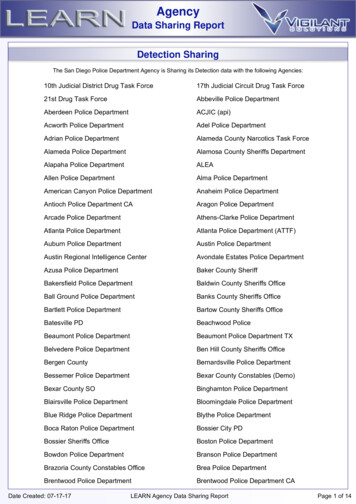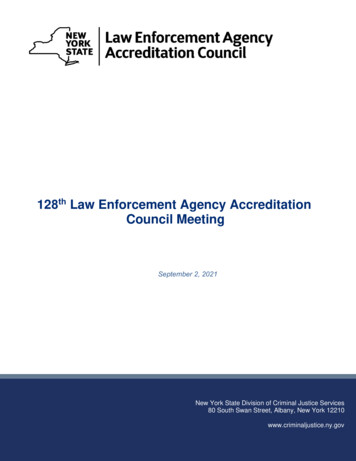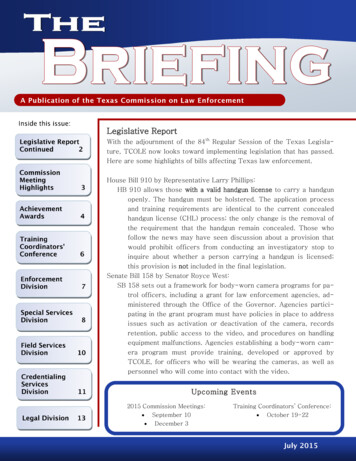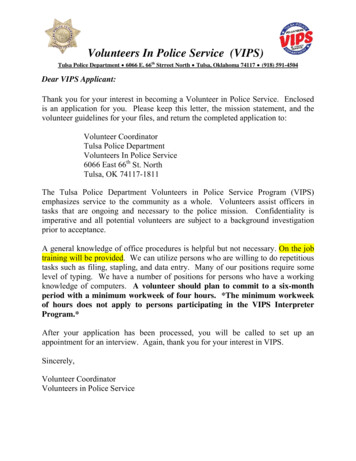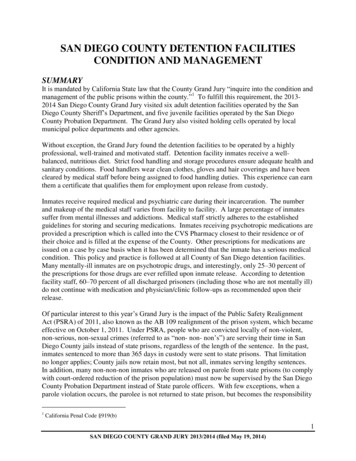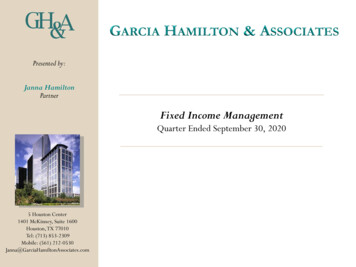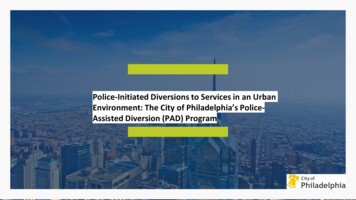
Transcription
POLICE IN THEEMERGENCY DEPARTMENTA MEDICAL PROVIDERTOOLKIT FOR PROTECTINGPATIENT PRIVACY1
AUTHORED BYWorking Group on Policing and Patient RightsABOUT THE AUTHORSWe are a working group of physicians, lawyers, clinical social workers, and law and medical students.We study law enforcement presence in emergency departments and support hospitals in developingpolicies to ensure patient rights are respected in interactions with law enforcement.1 We arecommitted to educating healthcare providers and hospitals on how they can interact with lawenforcement officers to safeguard patient rights, promote safety, and improve health outcomes. Whilethe ongoing national conversation around police violence and accountability raises broad questionsabout police activity in many settings, we are sharing this document with the more limited goal ofproviding practical guidance that can be immediately implemented by healthcare workers given thelaws and resources that currently exist.We are grateful to the Georgetown University Health Justice Alliance (HJA), an academic medicallegal partnership (MLP) working to train the next generation of leaders in health justice, for connectingthis group of researchers and students and supporting publication of this toolkit. HJA recognizesthat MLPs increase health equity not only by addressing individuals’ legal needs but also by creatinginstitutional and systemic level change and empowering medical professionals to be advocates fortheir patients. For more information about the Georgetown University Health Justice Alliance, ce. For more information about the MLP approach andmovement visit the National Center for MLP at medical-legalpartnership.org 2021 Working Group on Policing and Patient Rights1Police can be present in a variety of other medical settings outside the emergency department, including inpatient hospital wards andoutpatient medical clinics. Police presence in those other contexts can raise similar concerns, and information in this toolkit may applygenerally. However, our recommendations are specifically designed to address police interactions in the emergency department.
EXECUTIVE SUMMARYLack of thoughtful hospital policies andprovider education regarding patient and staffinteractions with law enforcement can lead toviolations of patient privacy, confidentiality,and autonomy. Law enforcement activityin the emergency department (ED) mayalso negatively impact patient-providerrelationships and patient health outcomes.Members of law enforcement are not expertson patient privacy, just as medical providers arenot experts on constitutional law. This toolkitprovides guidance to ED providers on thelaws and legal consequences related to theirinteractions with police. This information willequip providers and other healthcare workersto safeguard their patients’ rights, comply withprivacy laws, and navigate law enforcementinteractions in a way that protects patients.Like all visitors, law enforcement officersdo not have a right to unrestricted ED access.In hospitals or EDs where police officers haveroutine or largely unrestricted access, it isusually because that facility, either throughpolicy or practice, does not restrict lawenforcement access to patient care areas.As is true in daily life, patients and providershave the right to refuse to speak with thepolice and to withhold their consent fromsearches of their person or property in theabsence of a valid court order or warrant.ED practices that casually expose protectedhealth information (PHI) to law enforcementor provide unrestricted police access topatient care areas violate patients’ rights,expand law enforcement intrusion intotheir care, and may result in serious legalconsequences for patients.There are steps that every ED providercan take today to ensure patients’ rightsare protected. In interactions with lawenforcement, ED providers should: Approach and identify officers who arepresent in patient care areas Refuse to consent to police questioning ofpatients, information disclosures, access,and searches and seizures without patientauthorization or legal authority such asjudicial warrants, court orders, and specifiedprobable cause Use formal processes to refer warrants,court orders, or other requests regardingpatient access or PHI to authorized partiessuch as an administrative supervisor, legaldepartment, or medical records departmentED providers should also advocate tochange their hospital’s policies regardinglaw enforcement activity, including: Visitor access Sharing of information with police Security, storage and searches ofpatient property Police requests for the performance oftests or procedures Family visitation when law enforcementis present Use of handcuffs, forensic restraints,and shackling3
BACKGROUNDEmergency department (ED) healthcareproviders are responsible for addressingpatients’ emergent medical needs whilesimultaneously protecting patient privacyand public health. These complex demandsfrequently require interacting with lawenforcement personnel who may already bein the facility as security, arrive with injuredpatients, or come to the ED seeking accessto patients, patient care areas, protectedhealth information, or the performance ofspecific medical tests or procedures onparticular patients.When hospitals and healthcare providersgrant law enforcement access to the ED orfulfill police requests without adhering toclear policies for evaluating these requests,they may inadvertently undermine patientprivacy and autonomy rights. This canhave serious consequences, includingcompounding the biases and racial disparitiesthat already exist in healthcare and lawenforcement. With national attention focusedon reexamining police presence in a variety ofsettings, hospitals and medical providers havea unique opportunity to do the same in theirhealthcare facilities.This toolkit is designed to educate medicalproviders on the laws and legal consequencesthat inform their contact with police.Although healthcare workers are often bestpositioned to safeguard patient privacy, theymay not have the legal training, expertise, ortime to best defend patient rights. Providers4may be unaware of how even minimalinteractions with police can adversely affecttheir patients. Our goal is to inform EDhealthcare providers and other workersabout the risks of police presence in the ED,provide guidance on how to protect patientrights in interactions with law enforcement,and offer advice on how to advocate forinstitutional policy changes in a hospital orhealthcare network.The information included in this toolkit willequip providers to safeguard patient rights,comply with privacy laws, and navigate lawenforcement interactions. Ultimately, patients’well-being should be at the center of all policiesand practices governing interactions betweenlaw enforcement and health care workers.This toolkit begins by answering generalquestions about policing in the ED, thenprovides practical guidance in the form ofmodel scripts for common interactions withpolice, and concludes with action items foradvocacy. It is a working document that willevolve as we learn more about patient andprovider needs. We welcome comments andsuggestions from readers with experience incommonly encountered scenarios and otherinteractions with law enforcement.Particular circumstances and individual statesand jurisdictions may impose specific legalobligations; thus, this document does notconstitute legal advice.
Why should I care about police activityin my ED?GENERALQUESTIONSLaw enforcement activity in the ED can threaten fundamentalrights that protect patient privacy, confidentiality, andautonomy. In addition to the legal and ethical principles thatrequire healthcare professionals to ensure patient privacy anddignity in the healthcare setting, the U.S. Constitution alsooutlines rights that protect all individuals, including ED patients,from unlawful police activity. Allowing police unregulated accessto patient care areas can undermine both sets of safeguards.At the very least, granting unregulated ED access to anyone,including police, allows patients’ protected health informationto be seen and heard by third parties. The unique position oflaw enforcement officers may also allow them, knowingly orunknowingly, to take advantage of this access and apparentauthority to pressure patients, visitors, and healthcare workersinto eroding patients’ constitutional rights.ED staff and hospital policymakers who understand their patients’rights are uniquely situated to safeguard them in interactionswith law enforcement. The professional, ethical, and legalobligations that mandate healthcare professionals and hospitalsto protect patient privacy rights provide a strong foundation forpatient advocacy with law enforcement.2, 3, 4, 5 Because courtsoften defer to hospital policy and healthcare professionals’decisions when determining the scope of patient rights inhealthcare settings, healthcare workers’ actions can profoundlyalter the course of patient interactions with law enforcement.Do police have a right to be in my ED?The short answer is no. There is no legal basis that grants policeunrestricted access to the ED or other hospital areas. As in anyother business, police have the same rights to access a hospitalas any member of the public.6 If a hospital area is closed to thepublic, it can be closed to the police. Like all hospital visitors,police can freely enter the premises only to the extent that theyare permitted to do so by the hospital or hospital employees.In the narrow circumstances where law enforcement officersdo have a legal right to enter without permission, their entrydoes not legally grant them wholesale access to an entire EDor hospital. For instance, when a judge issues a search warrantor in the presence of an imminent safety threat, police access“Confidentiality of Patient Information.” ACEP, y.” American Medical Association, 14 Nov. 2016, ality.4“Law Enforcement Information Gathering in the Emergency Department.” ACEP, partment/.5“Privacy and Confidentiality - ANA Position Statement.” ANA, onfidentiality/.6Moskop, John C., et al. “From Hippocrates to HIPAA: Privacy and Confidentiality in Emergency Medicine—Part II: Challenges in theEmergency Department.” Annals of Emergency Medicine, vol. 45, no. 1, 2005, pp. 60–67. doi:10.1016/j.annemergmed.2004.08.011.235
GENERAL QUESTIONSis legally restricted to the purposes justifyingtheir entry. Consequently, when police officershave routine or largely unrestricted access to ahospital or ED in the United States, it is usuallybecause that hospital, either through policyor practice, does not restrict law enforcementaccess to patient care areas.How do police enter my ED?In the absence of hospital policy governinglaw enforcement entry into patient care areas,police often end up informally accessing the EDwithout a clear purpose or legal justification.Police can enter the ED by arriving withpatients in the trauma bay, following hospitalstaff through key card secured doors, or simplywalking into patient care areas when accessis uncontrolled. Without thoughtful hospitalpolicies, police officers can linger in the EDwithout having a clear reason for being presentand may inappropriately seek information orphysical property from patients, healthcareworkers, or other visitors.Hospital administrators andstaff should be united in theircommitment to protecting patientprivacy and safety.Because police do not have an unrestrictedlegal right to enter patient care areas, hospitalsand EDs can take important steps to controltheir access. Organizational policies shouldclearly outline the limited circumstances inwhich police may be allowed to enter the ED.At a minimum, law enforcement officers shouldbe required to register as visitors by providingtheir name, badge number, and a valid reasonfor entry. Officers should be required towear temporary hospital visitor identificationwhenever they enter. Hospital administratorsand staff should be united in their commitmentto protecting patient privacy and safety.6Hospital security officers are another sourceof policing in the ED. Hospitals may hire onsite security personnel by contracting withlocal police departments or employing privatesecurity services. These arrangements canresult in increased policing of patients. Mostdirectly, police officers hired by the hospitaland off-duty police officers working as privatesecurity staff have the authority to makearrests and may share information and physicalevidence with police investigators, ultimatelyharming patients’ legal rights. On-site policeofficers and private security staff may also becalled on to handle interpersonal conflicts andmay be involved in conducting patient roomsearches and restraining patients, even withoutreceiving training on de-escalation, conflictresolution, and patient rights. Because hospitalpolice are hospital employees, their actionsshould always be held to hospital patientprivacy standards, including protecting patientinformation and autonomy and safeguardingpatient belongings.How can police presencein the ED harm patients?POLICE PRESENCE CAN UNDERMINEPATIENT PRIVACYPatients in the hospital and ED have anexpectation of privacy grounded in medicalethics and state and federal laws. Nationally, theprivacy rules outlined in the Health InsurancePortability and Accountability Act (HIPAA)legally establish the confidentiality of protectedhealth information (PHI). Although police mayseek the disclosure of PHI from healthcareworkers while present in the ED, patientshave the right to keep information about theirmedical care confidential from all third parties,including law enforcement officers.Disclosures of PHI to law enforcement officersmay be unlawful if they fail to satisfy HIPAA’scomplex legal standards governing release ofinformation to law enforcement. Beyond limitedmandatory reporting requirements that varyby state—for example, for situations involvingchild or elder abuse—HIPAA only allows fordisclosure of PHI in very narrow circumstances.
GENERAL QUESTIONSSharing PHI is only legally required in specificsituations, such as when state-mandatedreporting laws apply or when a judicial warrantor court order is presented.7 Given the technicalnature of HIPAA compliance and the enhancedprivacy protections that exist for patients whomay be victims of crime, it is easy for healthcareworkers, especially in the trauma setting, toinadvertently disclose more information topolice officers than is lawful. Because HIPAAexceptions are so tightly-regulated by law,disclosure may ultimately expose healthcareworkers and their hospital systems to legalliability. Formal processes to evaluate lawenforcement requests for information should bein place. Frontline healthcare workers are rarelyequipped to analyze the HIPAA implicationsof any given request for information or thelegality of judicial warrants or court orders.Law enforcement officers who are seekingpatient information (including name, injuries, orcondition) should be referred to the hospital’slegal or medical records department.In addition to risking PHI disclosures inviolation of HIPAA, police activity in patientcare areas can threaten patient privacy inother ways. Law enforcement officers can anddo use passing comments made by medicalproviders as evidence in legal proceedings.For instance, police may ask medical staff inthe ED for a patient’s name, injuries, or status.Medical providers’ responses can have seriousconsequences for patients, such as being usedto run a warrant search, initiate deportationproceedings, or provide law enforcementwith the grounds to conduct interrogations ofvulnerable patients unable to provide consent.Similarly, mentioning to law enforcement that apatient is coherent or giving law enforcementpermission to question a patient can later beused to demonstrate that a patient had thecapability, capacity, and mental state needed togive consent to police interrogation or searches,even if the patient did not.Police presence can also violate the privacy ofevery patient in a care area, even those whonever interact with law enforcement officers.These diffuse risks to privacy range from policebody cams that can record images or audio ofmany patients at a time to the intentional oraccidental disclosure of PHI to law enforcementofficers.8 Police may overhear sensitiveinformation or private conversations, includingPHI related to patients who are not underpolice investigation. Police may see privatepersonal belongings in patient care areas,including the trauma or resuscitation bay, andpolice may seek information or property fromanyone they encounter. Healthcare providersshould understand that it is possible for lawenforcement officers to use any information orproperty that they gather as evidence againstpatients, visitors, hospital staff, or other parties.POLICE PRESENCE CAN UNDERMINEPATIENTS’ CONSTITUTIONAL RIGHTSPatients—like all individuals—have constitutionalrights that protect them from illegal policeactivity. Whether by explicitly inviting policeinto patient care areas or by passively allowingtheir entry, hospitals and healthcare workersthat allow unregulated law enforcement accessto the ED or that share patient informationor property with law enforcement can createsituations that exempt the police from severalimportant legal safeguards that wouldotherwise protect patient rights.First, when police are permitted into the ED byhospitals or healthcare workers, they may beconsidered “lawfully present” and, therefore,able to seize items that are within their “plainview” without a warrant. By allowing policeactivity in the ED, hospitals and healthcareproviders place any patients, patient property,PHI, and sensitive conversations that arevisible to or within earshot of the police in thepolice’s “plain view.” The police can and douse information or physical evidence that they745 C.F.R. § 164.512.; (OCR), Office for Civil Rights. “505-When Does the Privacy Rule Allow Covered Entities to Disclose Informationto Law Enforcement.” HHS.gov, 18 July 2017, udiovisual Recording in the Emergency Department.” ACEP, June 2019, epartment.pdf “Recording ED staff or patients should be a deliberate decision.Use of always-on recording devices, whether by hospital personnel, law enforcement officers, or other persons, should be regulated andrestricted to areas in which patient care is not occurring and there is no reasonable expectations of privacy and confidentiality.”7
GENERAL QUESTIONSencounter, observe, or overhear in the ED. Thisinformation and evidence can be used againstpatients in legal proceedings.Second, when hospitals, including hospitalsecurity, turn over information or physicalproperty to law enforcement, the police canavoid constitutional scrutiny entirely throughthe legal principle known as the “third-partydoctrine.” The legal requirements spelled outin the U.S. Constitution—including FourthAmendment rights against unlawful searchesor seizures of persons or property—are rulesabout how the government can treat individualsand other private parties. They generally do notapply to how citizens or private organizationstreat one another.9 If the police receive propertyor information from a “third-party,” such asa hospital or medical provider, they do notneed a warrant. By turning patient property orinformation over to the police or conductingprocedures at the request of police, hospitalsfacilitate the erosion of patients’ constitutionalrights. These types of “third-party” actions caninsulate the police from legal liability, preventingpatients from successfully defending their rightsin future legal proceedings.10Third, hospitals that routinely allow lawenforcement to visit ED patients who are notin custody make it more difficult for patientsto exercise their right to refuse to speak withthe police. Choosing to speak with the police isalways voluntary. Allowing police into patientcare areas without securing informed patientconsent can undermine patients’ ability todecline police interactions. Patients in theED, especially trauma victims, are frequentlyuncomfortable, distressed, medicated, ordisoriented and may not be well positioned toadvocate for themselves. Additionally, becausepatients cannot easily leave the ED while theyare receiving care, police questioning in aChoosing to speak with thepolice is always voluntary.hospital setting can allow the side-stepping oflegal rules that ordinarily govern interrogationsof individuals who are detained, in policecustody, or otherwise not free to leave.POLICE PRESENCE CAN INFRINGE ONPATIENT AUTONOMYWithout thoughtful hospital policies, police inthe ED may inappropriately linger around orfollow patients and may actively or passivelyrestrict patients’ autonomy. When police arepresent, hospital staff may falsely believe thatpatients are under arrest or being detained andfeel pressured to comply with police requests,even in the absence of patient consent.Additionally, patients may not feel freeto share important PHI with their providers normake autonomous decisions about their care.11Police may also infringe on patients’ physicalautonomy by using handcuffs or shackles torestrain patients who are in custody. Theserestraints can violate medical ethics andhave disastrous effects on a patient’s healthand psyche when not medically necessary,particularly when patients are pregnant or havebeen victims of physical trauma.12Patients have the right to deny consent inpolice interactions and should be able to makeimportant decisions free from the impliedauthority of police presence. Respect forpatient autonomy is one of the core principlesof medical ethics. The principle should extendto patient interactions with law enforcement,such as questioning or surrendering of propertyin the absence of a valid court order or warrant.9Public hospital employees may be considered state actors when they act as a third-party agent of law enforcement, potentiallyexposing individual healthcare workers to liability for constitutional rights violations.10Although police are not legally responsible for the actions of third-parties who provide information to law enforcement, those thirdparties can be independently liable for wrongdoing. Making unauthorized discretionary disclosures to law enforcement officers mayexpose hospitals and healthcare workers to litigation and legal liability for violating patient privacy laws or other tort and statutoryactions.11Jacoby, Sara F., et al. “A Safe Haven for the Injured? Urban Trauma Care at the Intersection of Healthcare, Law Enforcement, and Race.”Social Science & Medicine, vol. 199, Feb. 2018, pp. 115–122. doi:10.1016/j.socscimed.2017.05.037.12Fettig, Amy. “ 4.1 Million Settlement Puts Jails on Notice: Shackling Pregnant Women Is Unlawful.” American Civil Liberties Union,American Civil Liberties Union, 26 Apr. 2015, gnant-women#: :text 20restrict%20the%20practice.8
GENERAL QUESTIONSGiving patients the unpressured opportunityto make decisions about their interactionswith the police is important for protectingpatient autonomy.Unregulated police presencein patient care settings canerode patient trust inmedical providers.POLICE PRESENCE CAN UNDERMINETHE PATIENT-PROVIDER RELATIONSHIPUnregulated police presence in patient caresettings can erode patient trust in medicalproviders. While healthcare providers havelegal and ethical obligations to protect patientprivacy, the same standards do not apply tolaw enforcement. It is reasonable for patientsto assume that police officers may useincriminating information against them, evenwhen disclosed for the purposes of medicaltreatment. As a result, patients may be unwillingto share important medical information withtheir providers when law enforcement is presentor when healthcare providers appear to beworking with law enforcement.Patients, especially those who are mostvulnerable, marginalized, or have been subjectto police mistreatment in the past, are likely tofeel uncomfortable, intimidated, or unwelcomewhen confronted by law enforcement in ahealthcare setting.13, 14 The full spectrum ofnegative health outcomes associated withover-policing, especially as it impacts Blackpatients, is beginning to be acknowledgednationally. Redesigning policies to protectpatient rights is consistent with the AmericanMedical Association’s recent call for hospitals,clinics, and healthcare workers to “review andreconsider their policies and relationships withlaw enforcement that may increase harm topatients and patient communities.”15How can police presence inthe ED threaten my or myhospital’s commitment toracial justice?Members of law enforcement carry into the EDthe same individual and systemic racial biasesthat are present in other aspects of policing.Although research is very limited in this area,studies have demonstrated that Black traumapatients report many negative experienceswhen law enforcement is present before, during,or after treatment in the ED.16 The continuinglegacies of racism and medical experimentationon vulnerable populations in American historycontribute to patient mistrust of healthcareproviders and police.17 Hospitals that contributeto inappropriate policing can exacerbatethe racism that Black, Indigenous, and otherpeople of color experience in the healthcaresystem. This racism is particularly evident inthe way many survivors of violent crime, whoare disproportionately nonwhite, are treatedas suspects by police and healthcare workerswhile receiving care.There is an urgent need for healthcareworkers to provide trauma-informed care toall patients, especially victims of violent crime.Consciously crafting hospital policies andpractices that explicitly protect patient rightsand support healthcare workers in advocatingfor their patients’ rights in interactions withlaw enforcement is an important part of thiseffort and can send a powerful message thatdemonstrates a commitment to racial justice.Jacoby, Sara F., et al. “A Safe Haven for the Injured? Urban Trauma Care at the Intersection of Healthcare, Law Enforcement, and Race.”Social Science & Medicine, vol. 199, 2018, pp. 115–122. doi:10.1016/j.socscimed.2017.05.037.14Alang, Sirry, et al. “Police Brutality and Mistrust in Medical Institutions.” Journal of Racial & Ethnic Health Disparities, vo. 7, no. 4, 2020Aug, pp. 760-768. doi: 10.1007/s40615-020-00706-w.15Police Brutality Must Stop.” American Medical Association, 29 May 2020, rutalitymust-stop.16Liebschutz, Jane, et al. “A Chasm Between Injury and Care: Experiences of Black Male Victims of Violence.” The Journal of Trauma:Injury, Infection, and Critical Care, vol. 69, no. 6, 2010, pp. 1372–1378. doi:10.1097/ta.0b013e3181e74fcf.17Kerrison, Erin M., and Alyasah A. Sewell. “Negative Illness Feedbacks: High-Frisk Policing Reduces Civilian Reliance on ED Services.”Health Services Research, vol. 55, no. S2, 2020, pp. 787–796. doi:10.1111/1475-6773.13554.139
How can I be a better advocatefor my patients’ rights?WHAT CANI DO?The first step to advocating for your patients is understandingtheir rights. Individuals have the right to refuse to speak withthe police. They have the right to withhold their consent fromsearches of their person or property unless there is a specificand valid court order or warrant. As a healthcare provider, youshould understand that your patients often have little to gainand much to lose from speaking with law enforcement officers,consenting to searches, or voluntarily turning over informationor belongings.When the police request something from you or your patient,you should not provide consent on your patient’s behalf.When police make a request, they either: (1) already have avalid warrant or other legal reason that they can get whatthey want, in which case you should refer the matter to yourlegal department,18, 19 or (2) do not have such a justification, inwhich case your consent only serves to give the police accessto information or property that the patient had the legal rightto keep private. The best way to safeguard your patients’ legalrights against unlawful police action is to not give any indicationthat you are providing consent for your patient to police actions.Even passively allowing police to access patients or patientcare areas can be interpreted as functionally consenting to lawenforcement activity on behalf of your patients. This passivity islikely to reduce your patients’ rights and expand police intrusioninto their care. Instead of surrendering patients’ rights, you shouldinform patients that they can refuse to consent to police activity,20and then you should leave the choice with your patient.Also, you should not consent to police activity on behalf of anincapacitated patient. If your patient is incapacitated and cannotgive consent, you should not give consent for them, either directlyor functionally through inaction or lack of hospital policy. Justas you would not perform a non-emergent procedure on anincapacitated patient without consent, you should not providelaw enforcement with access to an incapacitated patientwithout consent. Similarly, patient consent s
interactions with law enforcement can lead to . violations of patient privacy, confidentiality, and autonomy. Law enforcement activity in the emergency department (ED) may also negatively impact patient-provider relationships and patient health outcomes. Members of law enforcement are not experts on patient privacy, just as medical providers are


